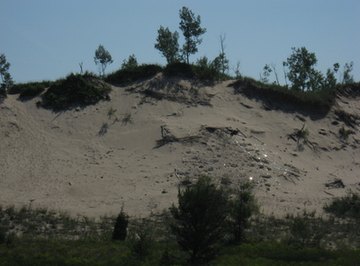
Indiana is home to several ecosystems, including wetlands, forests and aquatic ecosystems. Humans can enjoy the natural beauty of Indiana's ecosystems with hiking and bicycling trails. However, Indiana's wildlife species and plants need the preservation of the state's ecosystems for their survival. Indiana has taken measures to ensure the longevity of its natural ecosystems by protecting forests, including Hoosier National Forest, and installing ecological preservation programs in its universities.
Wetlands
Although there are many types of wetlands -- swamps, bogs and marshes -- these areas share common traits. The surface of wetland areas is typically water. Wetlands are primarily found near major sources of water, such as lakes and rivers. Examples of wetland areas in the Hoosier State include areas surrounding the Wabash River and Patoka River in the southwestern region of the state. These type of ecosystems are home to many bird and reptile species. According to studies from Indiana University-Purdue University Indianapolis, only 3 1/2 percent of Indiana's surface area is wetland. Much of Indiana's original wetlands, which constituted 24 percent in the 19th century, has been lost due to drainage and highway construction.
Forests
A forest ecosystem is defined as a region with a dense growth of trees. According to the Indiana Department of Natural Resources, Indiana has over 4 million acres of forested area (about 20 percent of the state's surface area) and about the same amount in cultivated timberland, of which about 87 percent is privately owned property. The state has several public state forests where visitors can enjoy recreational activities such as hiking, picnicking and bicycling. Some of Indiana's forests include Hoosier National Forest and Brown County State Park. Most of the forests in Indiana are considered hardwood forests, composed of oak and hickory or ash, elm and cottonwood trees. Forests are home to many species of mammals, birds and reptiles.
Aquatic Ecosystem
An aquatic ecosystem thrives within a body of water. The primary aquatic ecosystem in Indiana is the coastal region of Lake Michigan, located in northern Indiana. All of Indiana's aquatic ecosystems are freshwater bodies of water. Indiana's aquatic ecosystems are home to wildlife species such as fish, amphibians and insects. Native Indiana trees, such as oak savannas, get much of their water from nearby aquatic ecosystems. One of Indiana's largest recreation areas with wildlife and plants that benefit from an aquatic ecosystem is the Indiana Dunes National Lakeshore. Other lakes and rivers with aquatic ecosystems in Indiana include Lake Monroe, Wabash River and Grand Lake St. Marys.
References
Resources
About the Author
Skip Davis has been writing professionally since 2005. His work has appeared in "Southern Literary Magazine," on various websites and in graphic panels at the Jackson Zoological Park in Jackson, Miss. Currently living in Southern California, Davis received his Bachelor of Arts in theater at Belhaven College.
Photo Credits
Dunes on Lake Michigan shore NW INdiana image by Steve Johnson from Fotolia.com
